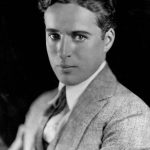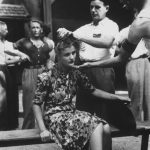The famous photograph capturing a sailor embracing and kissing a woman in Times Square, after news broke of the Japanese surrender in World War II, on August 14, 1945, has etched itself into history.
Commonly referred to as “The Kiss,” it became the celebrated symbol of the war’s end, marking the shift from dark times to a peaceful era.
The making of the photo
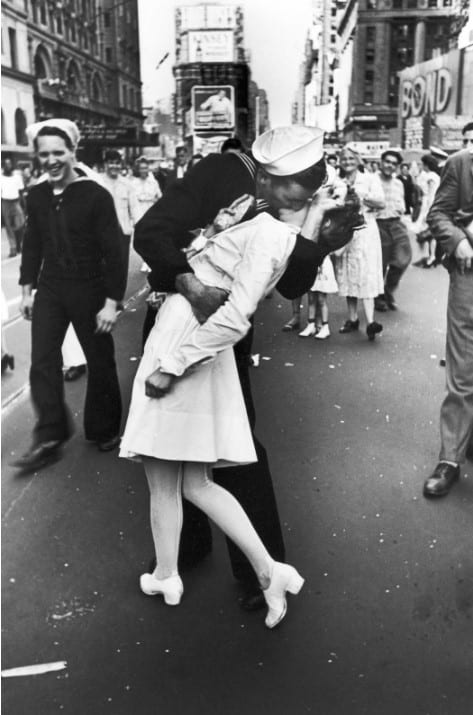
After four years of blackout, Times Square was suddenly ablaze with light as Mayor LaGuardia delivered the news of Japan’s surrender.
In a jubilant display echoed worldwide, New Yorkers flooded into the Square, marking the dawn of a new era filled with peace and hope. This iconic moment was immortalized by Alfred Eisenstaedt’s photograph capturing the embrace of an unknown couple locked in a kiss.
On August 14, 1945, amidst the jubilant celebrations of Victory over Japan Day, a U.S. Navy sailor, caught up in the euphoria of the moment, grabbed and kissed a woman in a white dress. This spontaneous moment was published in Life magazine a week later as part of a comprehensive coverage of nationwide victory celebrations.
Eisenstaedt’s photograph symbolizes the exuberance and relief felt across the nation at the end of World War II. Despite its iconic status, there remains some variance in Eisenstaedt’s accounts of capturing the moment and the essence of the photograph, as recounted in different publications.
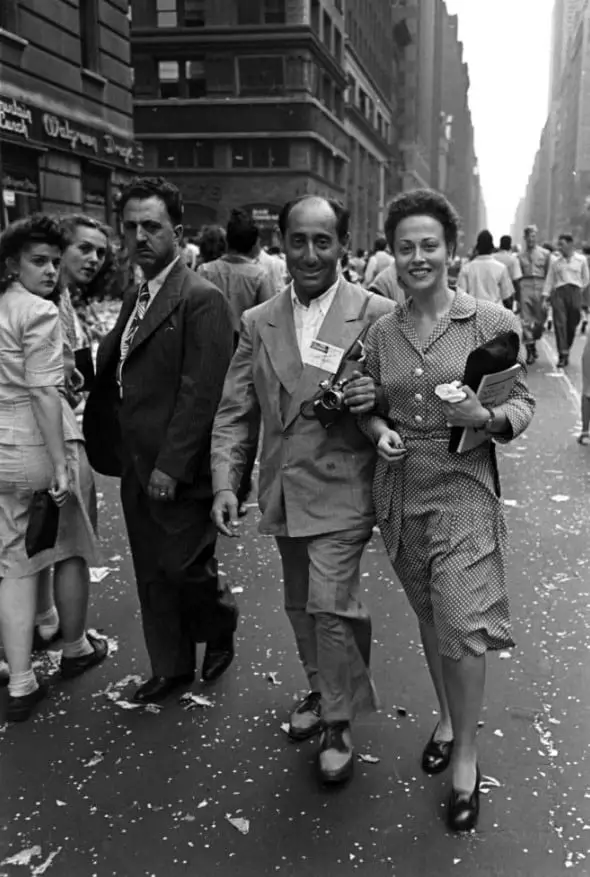
From Eisenstaedt on Eisenstaedt:
“In Times Square on V.J. Day I saw a sailor running along the street grabbing any and every girl in sight. Whether she was a grandmother, stout, thin, old, didn’t make a difference. I was running ahead of him with my Leica looking back over my shoulder but none of the pictures that were possible pleased me. Then suddenly, in a flash, I saw something white being grabbed. I turned around and clicked the moment the sailor kissed the nurse. If she had been dressed in a dark dress I would never have taken the picture. If the sailor had worn a white uniform, the same. I took exactly four pictures. It was done within a few seconds. Only one is right, on account of the balance. In the others the emphasis is wrong—the sailor on the left side is either too small or too tall. People tell me that when I am in heaven they will remember this picture.”
From The Eye of Eisenstaedt:
“I was walking through the crowds on V-J Day, looking for pictures. I noticed a sailor coming my way. He was grabbing every female he could find and kissing them all—young girls and old ladies alike. Then I noticed the nurse, standing in that enormous crowd. I focused on her, and just as I’d hoped, the sailor came along, grabbed the nurse, and bent down to kiss her. Now if this girl hadn’t been a nurse, if she’d been dressed in dark clothes, I wouldn’t have had a picture. The contrast between her white dress and the sailor’s dark uniform gives the photograph its extra impact.”
Eisenstaedt made sure to own the rights to the photo. He only allowed a few copies to be made and controlled how it could be used.
The image captured from another view
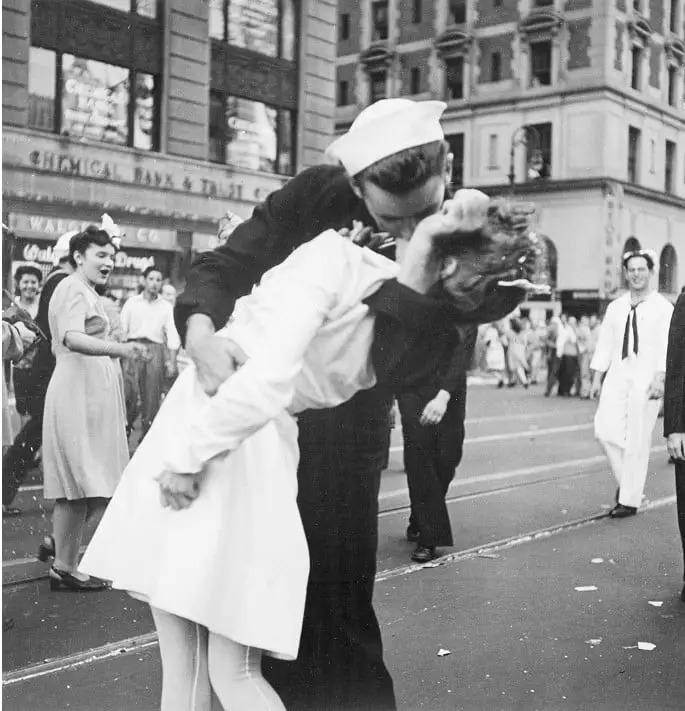
Victor Jorgensen, a Navy photojournalist, captured another view of the same scene that later featured in The New York Times. Titled “Kissing the War Goodbye,” Jorgensen’s photo offers a different angle of Times Square.
Unlike the famous V-J Day photograph, Jorgensen’s image appears darker and reveals fewer details of the individuals involved, notably obscuring their lower legs and feet.
While the Eisenstaedt photo is protected by copyright, this Navy image is in the public domain since it was taken by a federal government employee during official duties.
Although the angle in Jorgensen’s photo may lack some artistic flair compared to Eisenstaedt’s, it precisely captures the iconic kiss spot in front of the Chemical Bank and Trust building, with the Walgreens sign visible in the background.
Notably, the surprised woman on the left in Jorgensen’s photo has been positively identified as Kay Hughes Dorius from Utah.
The identity of the unknown couple
Decades later, the unknown couple from the iconic Times Square photograph was finally identified as George Mendonsa, an American sailor, and Greta Zimmer Friedman, a nurse.
On that historic day of August 14, 1945, Greta, then 21 years old, had just arrived at her job at a dentist’s office when she received the momentous news: Japan had surrendered and World War II was coming to an end.
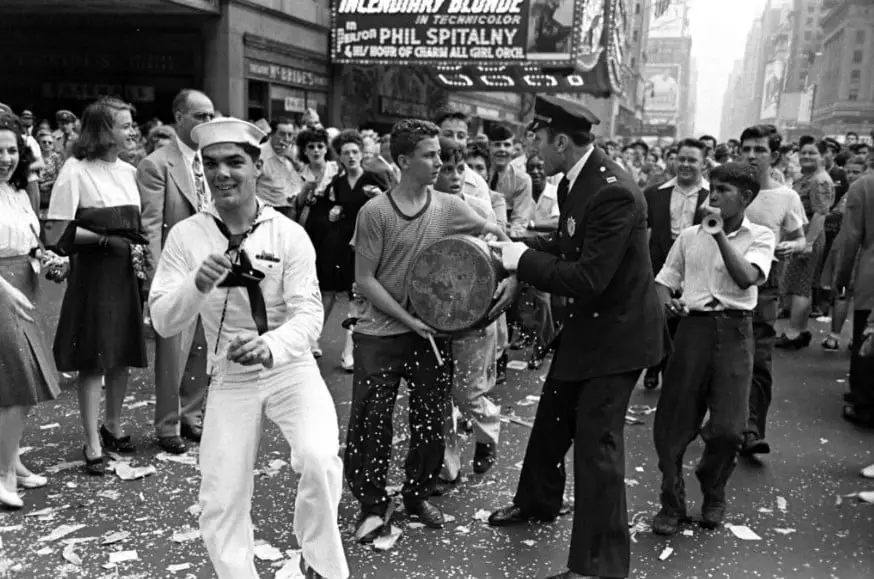
Eager to join the jubilant atmosphere, she wandered into Times Square. Little did she know, a passing sailor would soon sweep her into an unexpected embrace. In a 2012 interview with CBS, she said “I did not see him approaching, and before I know it I was in this vice grip.”
“It wasn’t my choice to be kissed. The guy just came over and grabbed. That man was very strong. I wasn’t kissing him. He was kissing me”.
The sailor behind the iconic kiss was the 22-year-old George Mendonsa of Newport, Rhode Island and stationed aboard the USS The Sullivans (DD-537).
He found himself at Radio City Music Hall, enjoying a movie with his soon-to-be wife, Rita, when the jubilant cries announcing the war’s end echoed through the doors.
George and Rita joined the party on the street and were swept up in the celebratory atmosphere. Unable to squeeze into the packed bars, they strolled along the sidewalk, reveling in the shared joy of the moment.
It was then that George saw a woman in a white dress walk by, he took her into his arms and planted a kiss on her lips, “I had quite a few drinks that day and I considered her one of the troops—she was a nurse”.
An alternate perspective on the photograph
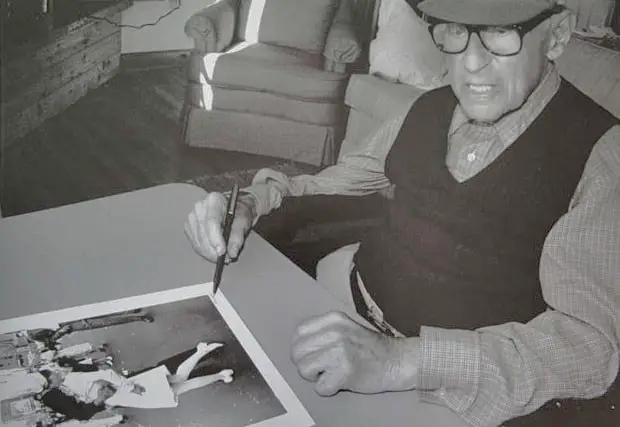
In 1997, art critic Michael Kimmelman described the famous Eisenstaedt photograph: the sailor representing returning troops, the nurse symbolizing those welcoming them home, and Times Square embodying the concept of home itself.
However, during the 2010s, bloggers began labeling it as a portrayal of a type of “normalized sexual assault.” The sailor, reportedly intoxicated, is depicted kissing an unwilling partner.
It was more serious when the nurse explicitly stated that the kiss she received was non-consensual, describing it as a mere “grab.”
Some people say the photograph describes a time when women were “subordinated to men” because of how the sailor is holding onto the nurse and the expressions of the people watching.

